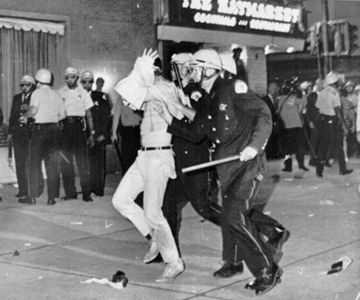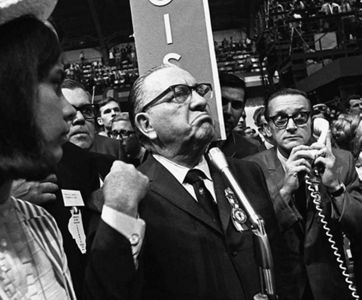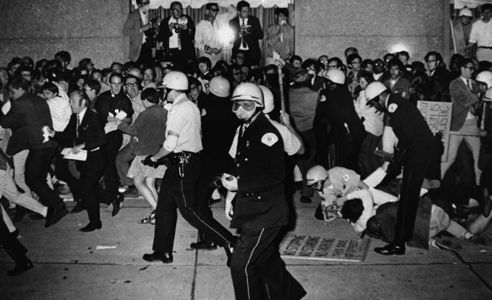CHICAGO (AP) — EDITOR'S NOTE: On Aug. 28, 1968, the delegates to the Democratic National Convention voted down a peace plank by a tally of 1,500 to 1,000. It put the match to the Chicago powder keg.
Hours after the afternoon vote, hundreds of demonstrators waged war with police on the streets of Chicago. "The whole world is watching," the protesters chanted. Presidential campaign watcher Theodore H. White, surveying the carnage, wrote simply: "The Democrats are finished."
An investigatory commission later described the scene as a "police riot." The young demonstrators taunted the police, "Oink, oink," and the police responded with swinging nightsticks and flying wedges.
Vice President Hubert H. Humphrey was nominated for the presidential race, but it was the hollowest of victories. The polls showed Republican Richard Nixon with a commanding lead. Humphrey himself observed: "I have pursued impossible dreams before, and maybe I am now."
Fifty years after the bloody confrontation, The Associated Press is making its story written that day by James R. Peipert available with photos.
___
Some 3,000 anti-war demonstrators fought a bloody, open battle with an equal contingent of police and Illinois National Guardsmen Wednesday night in an assault on the downtown headquarters of the Democratic National Convention.
There were mass arrests and some 300 injuries as police clubbed at the demonstrators, who have massed in Chicago by the thousands to protest against administration war policies.
Rocks and bottles were thrown, car windows broken, trash cans overturned and set afire, and heads were beaten in a five-block stretch along fashionable South Michigan Avenue, main street of Chicago's showcase front yard.
Vice President Hubert H. Humphrey was in his 25th-floor suite of the Conrad Hilton, which fronts on Michigan Avenue, awaiting an appearance before the convention at the International Amphitheatre, five miles south. A Humphrey aide said tear gas could be smelled in his room as police battled demonstrators in the hotel ground floor lobby.
Sen. Eugene J. McCarthy, candidate for the presidential nomination, also was in the hotel. His wife, ready to leave for the amphitheater, was detained by the Secret Service for security reasons.
The whereabouts of Sen. George S. McGovern, another candidate, was unknown.
Later Wednesday night, two miles north of the downtown area, some 30 youths were taken into custody in Lincoln Park after they threw rocks at passing police cars. Police fired two or three shots into the air, and the youths stopped the rock fusillade.
Deputy Superintendent James M. Rochford told the anti-war leaders that the group could stay in Grant Park as long as they wanted if they remained peaceful.
The youths — some bearded and sandaled, others clean-cut — have been in Chicago since last weekend to demonstrate their displeasure over Johnson administration policies concerning the Vietnam War.
They chose Wednesday — the day the presidential candidate was to be selected — for their major movement. More than 100,000 anti-war demonstrators had been promised by the administration opponents. About 10,000 showed up.
The rush on the Hilton came after guardsmen, using tear gas, foiled an anti-war march on the amphitheater, where a dovish Vietnam plank was rejected by delegates.
The demonstrators broke through police and military lines in Grant Park across from the Hilton, and stormed the hotel, where they were beaten back and went rampaging through the streets.
Police met any rush head-on, clubbed the demonstrators and threw them in vans headed for the central detention lockup.
Central Police Headquarters said it could give no estimate of those arrested. The staff was too busy, a spokesman said.
Several spectators were also seen beaten as police moved into a crowd and dispersed them. The spectators joined the demonstrators jeering police.
Many of the injured suffered, hand, arm and head fractures. One policeman was bitten on the neck.
One young man entering the Hilton, which was closed to all persons except those having their room keys with them, said, "Wait till they bust up a delegate."
About 1,200 guardsmen reinforced police, some of them driving in wire-covered jeeps. Almost all had their bayonets unsheathed.
As the police wielded clubs, clearing the area in front of the Hilton, guardsmen moved in fast and set up skirmish lines. The demonstrators scattered and ran, with police chasing.
Hotels flanking the Hilton closed their doors. All traffic along and near Michigan Avenue in the battle area was stopped.
The mass of demonstrators broke into smaller groups and continued to fight police, who repeatedly called for help.
At Michigan and Jackson streets, north of the Hilton, 150 police armed with shotguns stopped all traffic and forcibly cleared the area. One hundred of them, not wearing gas masks, were stricken by their own tear gas and went down to their knees, choking.
The groups filtered into the main downtown district, and headed for the Civic Center at Randolph and Clark streets. Squads of police in groups of 100 and 200 followed them, making mass arrests.
Demonstrators swarmed on a police van, rocked it and broke a headlight. They set on police defending themselves with clubs and scattered wen a line of shotgun-armed police reinforcements struck the group with rifle butts.
The demonstrators shouted, "Shoot, shoot, shoot!" Others said, "Go ahead, pig, shoot me." Several of the demonstrators were arrested before fleeing. "Pig" is the hippie term for policemen.
As police moved into the downtown district after the demonstrators, a young Negro standing in the doorway of the Greyhound bus station on Randolph Street was arrested. He told them he was not part of the crowd.
Police forced the groups north, toward the Chicago River, where the Tribune Tower, the Wrigley Building and Equitable Building are clustered on Michigan Avenue.
Two newsmen were arrested in the Conrad Hilton melee. Tom Corpora of United Press International reported he was arrested when he demanded the name of a police officer who, he said, verbally insulted him.
The consul-general of France confirmed that, Jean Vasal, an accredited photographer, was arrested at the Hilton and forcibly thrown in a police van.
The Medical Committee for Human Rights reported treating more than 300 persons for injuries suffered in police confrontations throughout the day.
National Guardsmen tossed tear gas canisters in the crowd as it moved out of the rear of the park toward the hotel. Police using clubs chased demonstrators through the hotel lobby.
The tear gas floated across Michigan Avenue and into the Conrad Hilton, causing discomfort to occupants in the building.
The demonstrators broke through the line of guardsmen and joined a mule train sent down Michigan Avenue by the Southern Christian Leadership Conference.
Some 3,000 demonstrators massed in front of the Hilton as police tried to divide the group and drive them back into Grant Park.
Eight blocks to the south, between the Coliseum, where protesters threw an anti-birthday party for President Johnson on Tuesday, and the Conrad Hilton, another skirmish was reported by police.
The demonstrators had planned earlier to march to the amphitheater but were stopped by 2,000 guardsmen and police. The police and the guardsmen surrounded the demonstrators, who had seated themselves on the grass in the rear of Grant Park.
Dave Dellinger, chairman of the National Mobilization Committee to End the War in Vietnam — organizers of the march — negotiated with police commanders, then talked to newsmen.
Dellinger said he wanted Mayor Richard J. Daley or John M. Bailey, Democratic national chairman, to come to the park and talk to him, and they would stay until they did.
"Baby sitting on the sidewalks ain't too bad either," he said. "We will sit here, come what may, because we are making our case before the world."
An hour earlier, police in wedge formations, moved into the crowds swinging clubs in unison in a bloody clash with protesters.
Then plainclothes men made a sweep through the mass of demonstrators. They broke picket sticks and singled out individuals, who, they warned, would be watched closely.
Demonstration marshals at the rear told the crowd through bullhorns that the police had informed them they could no longer stay in the park.
Most of the loosely bunched group at the rear, about 200 who never had actually joined the body of the march, quietly left.
The park lawn was littered with handbills plumping for various reasons.
One of the early casualties of the later afternoon skirmish with police was Rennie Davis, coordinator of mobilization, who was taken to Michael Reese Hospital for treatment of scalp and arm and back wounds.
The policemen were showered with rocks, trash cans and sticks as they moved into the crowd in wedge formations, swinging their sticks in unison.
Police moved the crowd to rescue several policemen who were surrounded by the crowd after they arrested a protester who lowered the United States flag to half-staff near the park band shell.
The crowd of protesters assembled in the park in preparation for a march on the fortresslike amphitheater despite police warnings that the march would not be permitted.
Police distributed notices among the crowd — estimated by police at 7,000 persons — gathered at the band shell in Grant Park, just east of the downtown Loop.
Copyright 2018 The Associated Press. All rights reserved. This material may not be published, broadcast, rewritten or redistributed.






